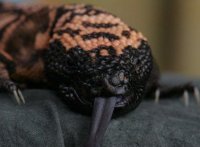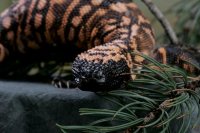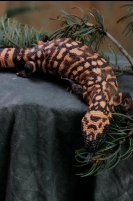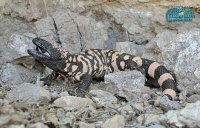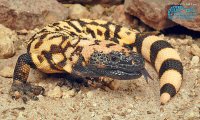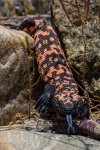| Range: |
 The Gila Monster reaches the eastern extent of its range in southwestern New Mexico, but the limits of the range are poorly understood. Its occurrence in Hidalgo and Grant Counties is well established, whereas origins of the small number of specimens and sight records from Luna and Doña Ana Counties have been questioned. The records from Kilbourne Hole in Doña Ana County and near Deming and Las Cruces are suspected to be released or escaped pets.
Gila Monsters are most regularly encountered in the central Peloncillo Mountains, Hidalgo County, and at Red Rock Wildlife Area, Grant County. The Gila Monster reaches the eastern extent of its range in southwestern New Mexico, but the limits of the range are poorly understood. Its occurrence in Hidalgo and Grant Counties is well established, whereas origins of the small number of specimens and sight records from Luna and Doña Ana Counties have been questioned. The records from Kilbourne Hole in Doña Ana County and near Deming and Las Cruces are suspected to be released or escaped pets.
Gila Monsters are most regularly encountered in the central Peloncillo Mountains, Hidalgo County, and at Red Rock Wildlife Area, Grant County. |
| Other Names: |
|
| Description: |
America's largest and most legendary lizard. The gila monster is distinctive among other reptiles. It is a large, heavy-bodied lizard with a massive head, a short, swollen sausage-shaped tail and a mottled pattern of black and pink, orange, or yellow beadlike scales. Its dark forked tongue flicks out in snake-like fashion. The legs are short and appear set too far apart to support the lengthy body. The feet have strong curved claws used for digging. |
| Similar Species: |
In New Mexico the Gila Monster should notbe confused with any other lizard. It is easily recognized by its large size, distinctive coloration and characteristic bead-like scales. Tiger Salamanders have a similar pattern, but it is yellow. They also do not get nearly as large and have smooth skin. |
| Venom: |
Although the venom is a neurotoxin as toxic as that of a coral snake, H. suspectum produces only small amounts. The Gila monster's bite is not fatal to healthy adult humans. No reports of fatalities have been confirmed after 1939, and those recorded prior to that year are possibly iatrogenic, or resulting from attempts to treat the bite itself. The Gila monster can bite quickly (especially by swinging its head sideways) and hold on tenaciously and painfully. If bitten, the victim may need to fully submerge the attacking lizard in water to break free from its bite. Symptoms of the bite include excruciating pain, edema, and weakness associated with a rapid drop in blood pressure.
The constituents of the lizard's venom that have received the most attention from researchers are the bioactive peptides, including helodermin, helospectin, exendin-3, and exendin-4. Exendin-4 has formed the basis of a class of medications for the treatment of type 2 diabetes, known as Glucagon-like peptide-1 agonists. Exenatide was the first product in the class to reach the market and was launched in 2005. |
| Habitat: |
Gila monsters are generally found below 5700 feet in elevation where Chihuahuan desert scrub merges with desert grassland. Habitats can be hilly and rocky in association with bluffs, rocky slopes, and arroyos. Of paramount importance is availability of suitable refuge shelters, which occur in rock cavities and crevices, pack rat mounds, and burrows created by other reptile and mammals. |
| Behavior: |
Diurnal in spring and fall and nocturnal in the summer. Adult and/or juvenile Gila Monster predators include foxes, coyotes, bobcats, mountain lions, badgers, hawks, owls, roadrunners, ravens, kingsnakes and rattlesnakes. In addition, domestic dogs and cats prey on the species where
Gila Monsters occur near human habitations. |
| Hibernation: |
Hibernates in burrows in October, emerging in March |
| Reproduction: |
Little is known about Gila monster reproduction. Males vie for access to females through ritualized combat. Mating takes place in shelters in April and May. Captive females tend to lay eggs in July and August. Clutch sizes vary between 5-13 eggs. Hatching usually occurs in the Fall. |
| Diet: |
Gila monster diets consist almost exclusively of mammal, bird, and reptile nests.
Ground squirrels, juvenile rabbits and rodents, doves and other birds that nest on the ground. |
Authored by: Jerry Tuttle
Sources:


|


